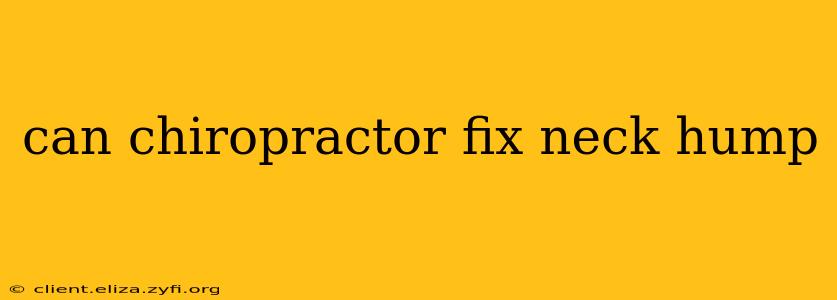A "neck hump," often referred to as a dowager's hump or kyphosis, is a noticeable curvature of the upper spine, resulting in a rounded or hunched posture. While a chiropractor can play a role in managing this condition, it's crucial to understand the limitations and the multifaceted nature of treatment. This article will explore whether a chiropractor can help and delve into other effective approaches.
What Causes a Neck Hump (Dowager's Hump)?
Before discussing treatment, it's essential to understand the root causes of a dowager's hump. This condition isn't solely a matter of poor posture; it's often a consequence of several factors:
- Osteoporosis: Weakening of the bones, particularly in post-menopausal women, can lead to compression fractures in the vertebrae, contributing to the hunched posture.
- Poor Posture: Sustained poor posture, whether from prolonged sitting at a desk, slouching, or other habits, can gradually worsen the curvature.
- Scheuermann's Kyphosis: A condition affecting adolescents, resulting in an abnormal curvature of the spine. This is often diagnosed during growth spurts.
- Ankylosing Spondylitis: A form of inflammatory arthritis affecting the spine, causing stiffness and eventually a hunched posture.
- Aging: Natural age-related degeneration of the spine can contribute to kyphosis.
Can a Chiropractor Help with a Neck Hump?
A chiropractor can indeed play a supportive role in managing a neck hump, but they cannot cure it in all cases. Their approach focuses on:
- Gentle Spinal Adjustments: Chiropractic adjustments aim to improve spinal alignment and reduce pain associated with the hump. However, these adjustments will not address the underlying bone density issues that contribute to the hump in osteoporosis.
- Postural Correction Exercises: Chiropractors often provide exercises to strengthen core muscles and improve posture, thereby reducing the prominence of the hump and mitigating further curvature. This is a crucial component of management.
- Pain Management: Many individuals with a dowager's hump experience pain and stiffness. Chiropractic techniques can help alleviate this discomfort.
What Other Treatments Are Available for a Neck Hump?
Depending on the cause and severity of the hump, other treatments may be necessary:
- Medication: For pain management and in cases of osteoporosis, medication may be prescribed to increase bone density.
- Physical Therapy: Physical therapy can help improve flexibility, strength, and posture through targeted exercises and stretches.
- Surgery: In severe cases, surgery might be considered to correct the spinal curvature. This is usually a last resort.
- Lifestyle Changes: Improving posture, engaging in regular exercise, and maintaining a healthy weight are all crucial in managing a neck hump.
Can a Chiropractor Diagnose a Neck Hump?
While a chiropractor can assess posture and palpate the spine to identify a neck hump, they are not always qualified to diagnose the underlying cause. A comprehensive diagnosis often requires medical imaging (X-rays or MRI scans) to determine the extent of the curvature and rule out other conditions. A physician or orthopedist should be consulted for a complete assessment and diagnosis.
How Can I Improve My Posture to Reduce a Neck Hump?
Improving posture is vital in managing a neck hump, whether or not you're under chiropractic care. Here are some tips:
- Be Mindful of Posture: Consciously check your posture throughout the day. Avoid slouching, and sit and stand tall with your shoulders back and relaxed.
- Strengthen Core Muscles: Strong core muscles support the spine and help maintain good posture. Include exercises like planks and bridges in your routine.
- Stretch Regularly: Stretching your chest, shoulders, and back can help improve flexibility and alleviate stiffness.
- Ergonomic Workspace: Ensure your workstation is ergonomically designed to support good posture.
Is a Neck Hump Always a Sign of a Serious Problem?
Not always. Mild kyphosis is relatively common, particularly with aging. However, a rapidly developing or significantly pronounced hump warrants medical attention to rule out underlying conditions such as osteoporosis or ankylosing spondylitis.
In conclusion, while a chiropractor can provide valuable support in managing a neck hump through adjustments, exercises, and pain relief, they are not a cure-all. A holistic approach involving medical diagnosis, physical therapy, and lifestyle changes often provides the most effective management strategy. Always consult a physician or other qualified healthcare professional for proper diagnosis and treatment.
